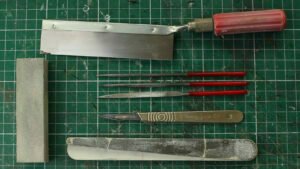Some quick tips for working with 3D printed models
As 3D printed parts are becoming more popular with manufactures, are there some better ways of working with them?
There are a number of ways I work with them, and these tips might help you with your next set of fittings.
Lets firstly explore the types of materials and printing processes commonly used.
The materials used are basically extruded plastic filament or UV cured resin.
The first is thin filament heated up and then squeezed through a fine nozzle, not that different to squeezing tooth paste from a tube.
The other type is a UV cured resin which can be in liquid or powder forms, and are cured in very thin layers using a precise UV light source.

So what’s the best way of working with them?
With all forms of sanding resin or plastic safety needs to be in place first, as fine dust is a by product of such work so a face mask is recommended.
The first one we will look at is the extruded plastic, which is quite often made from corn starch and can be a bio-degradable product. So when shaping or finishing the surface light sanding is recommended as causing to much heat say from a electric sanding tool can cause the part to deform or even melt.
These models will bond well to a car body filler normally with out any issues, and will aid hiding the banding caused by the layering process.
Paint can be applied without to much of a challenge, just use a good primer first. Also ensure the complete model is sealed with a final coat of paint both on the outside and in the inside, to help stop the part from degrading over time.
Resin prints on the other hand need a little extra care when working on them, as small fine details can be brittle. This happens when the UV light from the sun continues to cure them, a process that can continue for many months after the model has been made. The curing process can be reduced once the model has some form of paint or finish that will block the UV rays.
These models can be worked with sand paper or another material to remove any support marks or banding effects. If removing larger supports I would recommend the use of a razor saw to cut the part off as this will save breakage.
Take extra care with the dust produced from sanding as this is very fine and can cause lung issues, so I tend to keep my sanding sticks and model wet to reduce the dust.
Both types of material can be joined with a two part epoxy or superglue, and fixed to other materials without to many issues just do a few tests on waste material before the main parts if unsure.
I would recommend the use of a good primer before painting as this will give a good key for the paint.
If you would like any guidance fell free to contact me.




